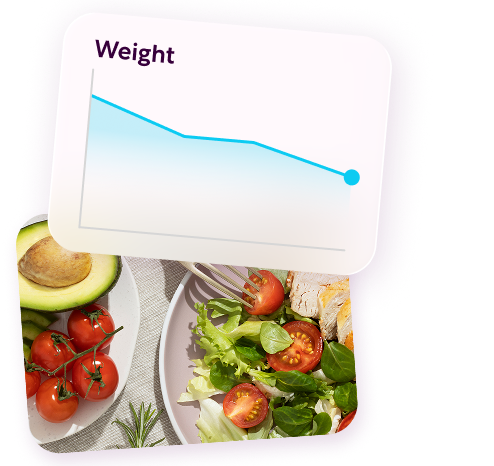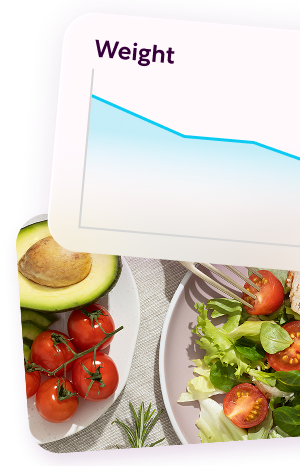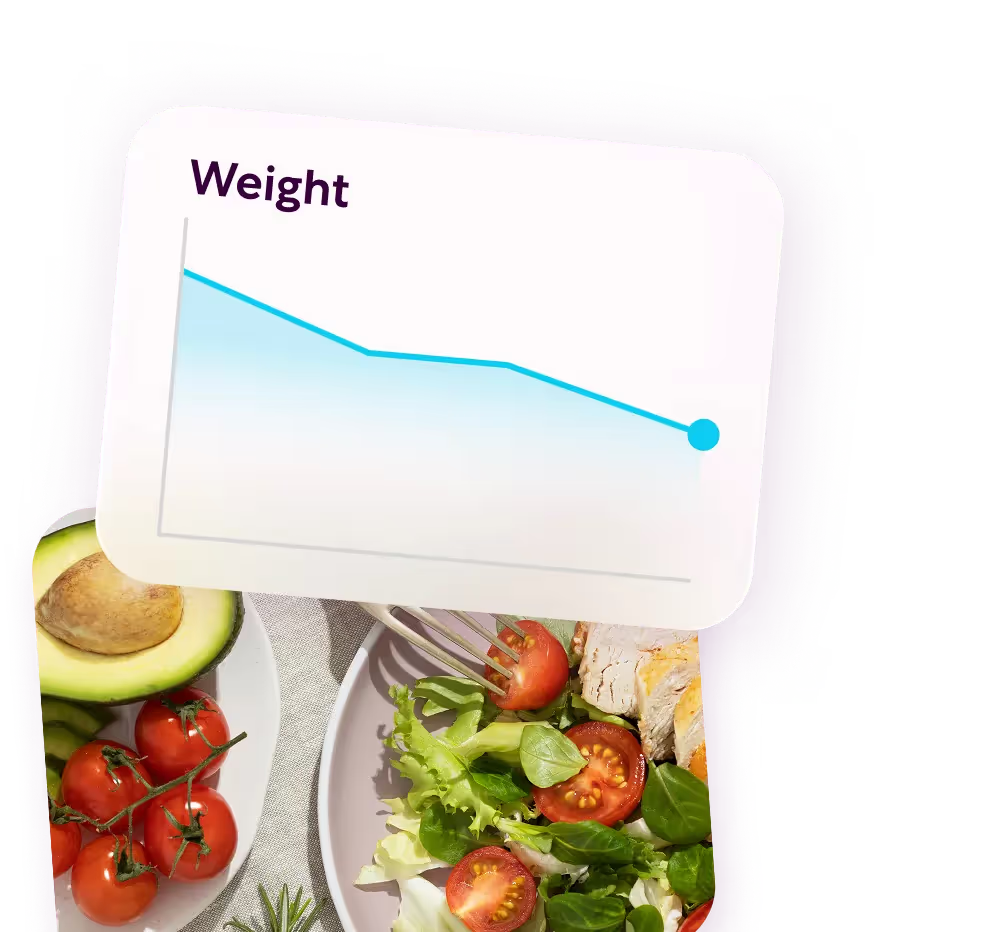Weight loss that fits your goals and your life.
Get your plan
Weight loss that fits your goals and your life.
Get your plan
Barre is a unique workout that blends elements of ballet, Pilates, and yoga. This low-impact exercise focuses on small, controlled movements that target specific muscle groups, including the legs, glutes, arms, and core. The core idea is to use small, controlled movements to improve strength, flexibility, and balance.
The method has become a popular method for weight loss among women because it’s fun and enjoyable while combining the benefits of strength training with cardio.
In this article, we’ll explore the science behind barre, how it works, its benefits, and how to use it successfully for weight loss.
What Is Barre and How Does It Work?

Created in the 1950s by Lotte Berk, a German dancer, Barre was designed to help dancers stay fit while protecting their bodies from injury. Since then, barre has evolved into a popular trend in fitness studios worldwide.
In a typical barre class, you'll perform a series of exercises using a ballet barre for support. The rhythmic nature of barre means that you can expect to move to upbeat music, making classes fun and energetic.
As you progress through the class, expect to feel the burn in your muscles, improved posture, and a more toned look.
The Origins of Barre Workouts
After Berk’s unique approach to fitness gained traction following the opening of her first studio in London in the late 1950s, one of her students introduced barre to the United States, where it has since become quite popular.
Over the years, barre has evolved to include elements from different fitness disciplines. Today, millions participate in barre classes across the country, drawn by its promise of a full-body workout that’s easy on the joints.
How Barre Helps with Weight Loss
Calorie Burn from Barre Workouts
One of the key benefits of barre workouts is the potential for calorie burning. While it may not seem as intense as running or cycling, a typical barre class can burn between 300 and 400 calories for someone weighing around 155 pounds. While the calorie burn may not be as high as in more intense workouts like running or HIIT, the unique combination of strength training and light cardio can make it just as effective, especially for your health.
Also, because barre focuses on high repetitions with low weights or body weight, your muscles have to work harder to stabilize during each movement. This type of training can lead to increased calorie expenditure both during and after your workout due to what's known as the afterburn effect.
Building Lean Muscle and Boosting Metabolism
Unlike traditional weightlifting that focuses on bulk, barre helps develop long, toned muscles. This is particularly beneficial during perimenopause and menopause as you start to lose muscle mass. The more muscle you have, the higher your resting metabolic rate becomes, and the less likely you are to gain weight.
The small, precise, and whole-body movements in barre help strengthen your core and improve overall muscle tone. Exercises such as pliés and relevés engage the legs, while arm workouts with light weights target the upper body.
Engaging all major muscle groups means that barre contributes to a more balanced physique.
Improving Flexibility and Posture
Flexibility is another area where barre shines. Many exercises focus on stretching and lengthening muscles. Better flexibility can make daily activities easier and reduce the risk of injury during other workouts.
By strengthening the core and back muscles, you’ll find yourself standing taller and feeling more confident. Good posture can reduce strain on your joints and muscles while improving your overall physical appearance.
Stress Reduction and Its Role in Weight Loss
You can expect to struggle with weight gain in your 40s. Combined with the stress of raising a family, personal relationships, and juggling a career, and you’ll find yourself at a much higher risk of developing conditions related to weight gain due to the increased cortisol levels. Barre workouts can help you fight triggers of unhealthy eating habits and reduce motivation for exercise.
The rhythmic nature of the exercises, combined with music, creates a calming atmosphere, releasing endorphins, the “feel-good” hormones that improve mood and reduce stress levels. With consistent practice, barre can also promote mental clarity and emotional well-being by providing a much-needed respite from day-to-day pressures.
Acting as a sort-of mental reset allows you to recharge and approach your weight loss journey with a clearer mindset. A clear mind is an effective way to manage stress, allowing you to stick to healthy eating habits and maintain an active lifestyle.
Barre vs. Other Workouts for Weight Loss

Barre offers unique benefits compared to other forms of exercise, especially for those seeking a low-impact workout that still delivers results.
Barre vs. Pilates
Both barre and Pilates focus on core strength and controlled movements. However, barre’s emphasis on muscle toning using small, isometric movements may lead to quicker visual results in muscle toning.
As an added bonus, barre workouts tend to have a faster pace than traditional Pilates classes, bringing an underrated cardiovascular benefit.
If your goal is a more dynamic and rhythmic approach to fitness, barre may be the better choice.
Barre vs. Yoga
In a typical yoga class, poses are held for longer periods, allowing for deep stretching and relaxation. Barre workouts usually involve quick transitions between exercises aimed at toning muscles. This makes it a more physically demanding exercise better suited for strength training.
If your goal is weight loss, barre might be the better option due to its higher calorie-burning potential during the workout. However, combining barre with yoga creates a well-rounded fitness routine. This combination allows for strength training and relaxation, which can help maintain a balanced lifestyle.
Barre vs. HIIT or Strength Training
High-intensity interval Training (HIIT) and traditional strength training often involve heavier weights and more explosive movements. These workouts can lead to substantial calorie burns and muscle gains in a shorter period. The only problem is that they aren’t beginner-friendly. They’re also not low-impact. This is a combination that most women in their 40s may struggle to keep up with.
Barre offers a gentler approach to building strength, endurance, and stamina without the high impact associated with HIIT or heavy lifting.
What to Expect from a Barre Class

If you're considering trying a barre class for weight loss, knowing what to expect during your first session is helpful. Classes typically follow a structured format that includes warm-up exercises, strength training segments, stretching, and recovery.
Warm-Up and Flexibility Movements
Most barre classes begin with a warm-up. This phase usually includes gentle stretches and movements that get your blood flowing and muscles ready to engage. As you ease into the class, expect to perform flexible movements that mimic the grace of ballet. A good warm-up sets the tone for the entire class, making you feel more connected to your body as you progress through the workout.
Strength and Core-Focused Segments
The core is a major focus in barre workouts. You’ll perform exercises that engage your abdominal muscles and improve overall core strength. Many classes also incorporate light weights or resistance bands to intensify the workout and engage different muscle groups.
Stretching and Recovery
At the end of the class, you'll go through a stretching segment that helps cool down your muscles. This part of the class allows your muscles to relax after an intense workout. Instructors often guide participants through deep stretches, targeting areas heavily worked during the class.
This recovery phase is just as important as the workout itself. During this time, you’ll also have an opportunity to reflect on your progress and how you feel after the session.
You might find this part of the class calming and restorative.
Tools and Equipment Used in Barre
In most barre classes, you'll find a ballet barre as the primary piece of equipment. Other equipment used in some studios include light dumbbells, resistance bands, and mats. These tools help provide additional resistance or stability as you perform different movements.
Who Can Benefit Most from Barre for Weight Loss?
Understanding who can gain the most from barre can help you determine if it's the best way to help you lose weight.
Beginners to Fitness
The low-impact nature of barre workouts makes them accessible for those who may feel intimidated by more intense exercises. The focus on form and controlled movements allows beginners to ease into a workout routine without overwhelming their bodies. The supportive environment in barre classes also fosters a sense of community, which can be motivational for those just starting out.
Those Looking for Low-Impact Alternatives
Older women might find barre a great way to stay active without causing discomfort, especially those who are already experiencing joint health. The lack of jumping and intense running in barre classes reduces the risk of injury while still offering a challenging workout. You can improve muscle tone, flexibility, and overall fitness levels while being mindful of your body's limits.
Individuals Focused on Core and Muscle Tone
You might find that barre can help you achieve a more sculpted figure while building a strong foundation of core strength. The exercises specifically target the core, glutes, thighs, and arms, helping to create a balanced physique.
Recap: Is Barre the Right Choice for Your Weight Loss Journey?
Key Benefits of Barre for Weight Loss
Barre workouts offer numerous benefits, making them a valuable addition to any weight-loss journey. Combining strength training and cardio elements helps users achieve a balanced workout that promotes overall fitness. You shouldn’t overlook the mental benefits of barre, either. The stress-reducing aspects of barre also contribute to a healthier lifestyle, helping you make better choices.
Steps to Start Your Barre Routine Today
If you want to incorporate barre into your fitness routine, find a local studio or online class that fits your schedule. Many studios offer introductory classes or trials, making it easy to explore barre without committing long-term.
Next, make sure to wear comfortable workout clothes that allow for movement. Bring a water bottle to stay hydrated, and consider investing in lightweight or resistance bands if they are not provided.
Finally, stick to it. Progress takes time. Like with any fitness program, consistency is key.
Weight loss that fits your goals and your life.
Get your plan
Sources
FAQs
How can barre workouts help with weight loss?
Barre workouts combine strength training, cardio, and high-rep, low-impact movements to burn calories, build lean muscle, and boost metabolism—helping with long-term weight loss.
Is barre effective for losing belly fat?
While no workout specifically targets belly fat, barre helps tone muscles, improve posture, and increase overall fat loss, which can lead to a slimmer midsection over time.
How often should I do barre to see weight loss results?
For noticeable weight loss, aim for at least 3-5 barre sessions per week, combined with a balanced diet and other forms of movement like walking or strength training.
Can beginners do barre for weight loss?
Yes! Barre is beginner-friendly and can be modified for all fitness levels. It’s low-impact but effective, making it great for those starting their weight loss journey.
Does barre help with muscle toning and definition?
Absolutely! Barre focuses on small, controlled movements that target specific muscle groups, leading to a lean, sculpted look without bulk.






